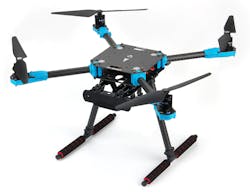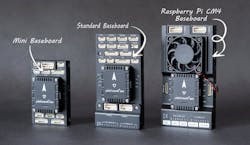This video appeared in Electronic Design and has been published here with permission.
Check out our AUVSI Xponential 2023 coverage.
So you want to build your own drone instead of buying one off the shelf. It's not much harder than building up a PC, since the platform and components have reached a level of standardization that make this easy. Vincent Poon, Chief Technology Officer at Holybro, shows off the components you can choose from to build a custom drone (watch the video above).
Holybro provides hardware platforms like the X500 V2 kits (Fig. 1). These provide the framework, motors, and propellers. The platform still needs additional hardware, such as an autopilot, GPS, and maybe cameras and other sensors.
The platforms are built with carbon fiber frames with fiber-reinforced nylon connectors. The motor connections have XT30 power plugs and the power distribution board (PDB) has XT60 and XT30 connectors that work with standard lithium-polymer (LiPo) batteries. It has mounting structures for autopilot, sensors, and GPS hardware that will be needed to make the drone fly.
Holybro also sells the autopilot flight controllers (Fig. 2), which are based on the Pixhawk open-source standard. These can run open-source autopilot software like PX4. Developers can also use custom software or enhance the open-source software for their application.
Autopilot systems typically handle motor control and basic sensor input to keep a drone flying straight. A host computer often provides higher-level planning and control so that they don't have to handle the real-time control of the motors.
Usually, a system will also require a GPS sensor and radio communication support, especially if a drone will be controlled remotely. Holybro provides all of these options, including first-person-view (FPV) subsystems that have camera inputs and video processing.
So Why Build Something from Scratch?
Many off-the-shelf drones have the ability to swap out some sensors or devices, such as cameras, but they rarely have the ability to interface with custom sensors like infrared cameras, LiDAR, radar, or gas sensors that might be useful in a particular application. These platforms allow for incorporation of these devices on the drone as well as make it easier to connect them to the host or autopilot computers.
A solution can be migrated to a production platform upon design of a system. The open frame and other aspects of the systems that make them a flexible development platform don't match what an end-user would want. The final system could still be designed around the development platform with improvements in packaging and wiring.
For those who simply want a drone that they have more control over, this type of platform is ideal. It can be enhanced with new hardware or additional sensors. The drones do have a weight limit, but larger drones require additional FAA licensing and training.
Links
The video transcript below has been edited for clarity.
So we are Holybro. We are a UAV hardware manufacturer based out of Shenzhen, China and my name is Vince and I'm the CTO of the company. What we do is we make drone components for various people, either students, research centers, or even commercial products, and a government agency. And our core of the business is a flight controller, one of these here, and GPS and telemetry radio.
This is our X500 v2 kit from from Holybro, and on here you got the Pixhawk 6X, one of our latest and most advanced autopilot flight controllers, and here we got the GPS. The M8N GPS is a low-cost, affordable GPS, and then we have a carbon-fiber frame, carbon fiber top plate and bottom plate and these motors, and also injection-molded parts. This whole kit without the front gimbal is around $500 and it is solderless. You do not need to learn how to solder to assemble it. And with one person, you could assemble this whole kit in about 20 minutes.
What we do is we build this component and you can buy this component similar to building a computer. And each component has has its own function and you can assemble it together with ease. And we provide documentation on how to assemble them. We do all the software open source and many of the hardware designs are also open source.
So, it's a great place for you to learn how to build a drone and get into the drone space. These are our flight controllers, also known as autopilots. And we offer three different models. Here we have the Pixhawk 6X. It is the most advanced autopilot we have here in our lineup.
It comes in a modular form. All of the processing of the flight control system is in this module, and you can put this module in a different baseboard. For example, this baseboard is a just a Nano, sorry, not just an Xavier NX baseboard, and it's in prototype at the moment. If you need AI and a computer-vision system where you need a lot of computation power, you can consider this baseboard. And if you are just simply trying to get the flight in the air and you can use another different type of baseboard, we offer five different baseboards. Two have not been released yet.
For example, this one has a Raspberry Pi CM4. The great thing about the Pixhawk 6X is that it follows the Pixhawk hardware standard and it uses the Pixhawk autopilot bus, which is basically the connector that it has. Any manufacturer that follows this Pixhawk standard can use our baseboard or we can use their baseboard.
So it's interchangeable. And if you're looking for something lower cost, we also have other other pilot's flight controllers. This one, for example, is called the Pixhawk 6C. It has less redundancy than the Pixhawk 6X, but it also still has a double IMU. And so it is a replacement of our previous Pixhawk autopilot controller. We also have a mini version of that and it really depends on the form factor of your drone.
You can choose a different flight controller based out of that. These are some of the GPS we offer. We offer something more affordable to you with meters accuracy up to something with centimeter accuracy. With this system called the RTK system, we offer multiple options, multiple sizes, and multiple different antennas.
There are two protocols. This is the DroneCAN protocol that we recently released and this is the Serial UR Protocol. It depends on what your budget is and what accuracy you need. We have many different models for you to choose from. So these are two of the telemetry radios that we offer. This is the Sik Telemetry Radio and it's one of the most affordable telemetry radios in the market.
And it's great for people who are looking for something plug-and-play. And if you need something longer range and more reliable from multiple drones, you can consider the Microhard Radio here. We have the P900 version and the P840 version at different frequencies. It's great if you have multiple drones that you want to connect to one single ground station.
Check out more of our AUVSI Xponential 2023 coverage.

